 A...
A... B...
B... C...
C... D...
D... E...
E... F
F
A) This is an aborted attempt to build a 50 volt power supply with no transformer by dumping charge into a capacitor bank directly from the mains. The meter shows that it does give 50 volts, but there were other problems, so the concept was abandoned. I am looking into transformers now. B) I will use some of these 60 volt, 20,000 uf caps in the power supply. C) The heat sink for the amp and the copper heat spreader is shown here. About 1000 watts of power has to dissipated here. D) These circuit boards will be mounted on the heatsink and spreader with the transistors shown in F mounted in between. E) These are the transformers. The large one is the output transformer that delivers 1000 watts from 160 meters through 6 meters. The transistors shown in F are a matched set of MRF154s that sell for about $900.00. That is why they are still in their protective container, and that is why I will get a few more gray hairs when I mount them and power them for the first time.
The part holes had to be located and drilled in the copper spreader. Pictures A, B, and C show the finished spreader. It was not an easy task. The first thing that happened is that I broke a 4-40 tap off in the copper. The copper was very gummy and would grab the tap. Since I had 20 holes that needed tapping, I decided to do it differently. Pictures A and C show the steel nuts that were sunk into the back side of the copper. This was done by enlarging the tap hole to a clearance hole and drilling a 1/4 inch hole half way through the copper from the back side. The steel nuts were then pounded into the copper and counter sunk using a 1/4 inch drift punch. This was much quicker and has the advantage of a steel thread insted of a copper thread. Also, if you break a screw, you can just pound the nut and screw out from the front side and replace the nut. The white circle in the lower left of picture B shows the repaired hole where I broke the tap. The tap was removed by drilling around it and pounding it out. This left a large hole (less than 1/4 inch, however) that needed filling on the top side so the spacer would sit straight. I sprayed a 4-40 screw with WD-40 and screwed the screw in and filled around it with epoxy. When the epoxy was set, the screw was removed and the epoxy was sanded flat. A friend of mine from work gave me a gift certificate for some "fine Chinese craftsmanship" (he is Chinese by the way). He was able to get the copper perfectly flat and smooth as you can see in the photos. This is necessary for efficient heat transfer. The aluminum heatsink was flattened and smoothed, also. The transistor specification sheet calls for the transistors to be torqued to 4-5 inch pounds when they are mounted. Pictures D and E show an improvised torque wrench using an allen wrench and a fish scale. The allen wrench was taped in two places to hold the hook on the scale 1 inch from the screw center. The screw was then tightened by pulling on the scale until it registered 4 1/2 pounds. Finally, the finished amplifier is shown in picture F. I do not have a power supply built yet, so I cannot test it out. However, I do have a 40 volt, 5 amp lab supply. I applied power to the regulator board and adjusted the regulator. It seemed to work right. I preadjusted both gate biases for zero. After installing the transistors, I slowly powered them up by bringing up the voltage to 40 volts. At about 15 volts, I heard a pop and the current incresed dramatically. I immediately shut off the power. I had seen a flash in the vicinity of the large input choke shown in the upper right of picture F. I checked the power input terminals with an ohm meter and found a dead short. I then removed that board, and the power input terminals were still shorted. I then removed a 0.47 uf chip capacitor on the input and the short went away. I think the cap must have been physically stressed in some way. I replaced it with a conventional capacitor, put the board back on, and repowered it. This time all went well. I slowly adjusted first one bias pot and then the other for 1 amp quiesent current from each transistor. I had the input of the amplifier terminated and a dummy load hooked to the output through a Bird wattmeter. Everything seemed stable in that there was no output on the meter. At this time, this is all the checkout that I have done.
The following photos depict hours of planning, measuring and metal cutting to form the structure and enclosure of the amplifier. Details of the pictures are described below.
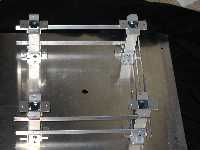 A...
A... B...
B... C...
C... D...
D... E...
E... F...
F...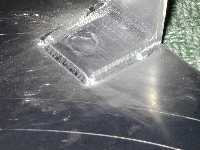 G...
G... H....
H.... I......
I...... J....
J.... K...
K... K1...
K1... L....
L.... M....
M.... N....
N....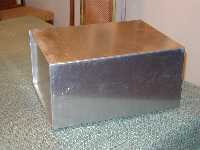 O....
O.... P...
P... Q
Q
Picture A shows the lower deck and the posts that will support
the upper deck. The hole in the middle of the bottom plate is clearance
for the the 1/2 inch bolt that holds the toroid, power transformer shown
in B. This transformer is a toroid that weighs 43 pounds and
measures 4 inches high and 10 inches in diameter. This transformer
is capable of 50 volts at 50 amps and will work from either 120 volt or
240 volt mains. Photos C and D show the top deck attached,
and photo E is a close up of the posts that support the upper deck.
These posts are strong, not because the upper deck is heavy, but because
the lower deck, which is heavy, is attached and might be moved by pressure
on the upper deck. F shows the crossflow blower made by ebm/PAPST
that will force air through the heatsink fins of the amplifier. This
fan is driven with a 43 watt, 115 volt motor and delivers 75 cfm at 0.2
in of H2O which is greater than the calculated flow and back pressure of
the finned heatsink. In order to have no screws showing on the front
panel, the mounting brackets were "welded" using a propane torch and a
special rod from Dura-Fix. Photos
H,
I,
J,
and K are pictures of the assembled amplifier, with H showing
the front and back panels (these panels are not finished at this time).
The toroid is mounted in the center and surrounded by the filter capacitors.
There are twelve 20,000 uf capacitors in parallel providing 0.24 farads
of capacitance. K1 shows the brass connecting straps
for the capacitors. These capacitors are secured to the side
rails shown in A, D, and
E with large nylon cable
ties. L and M are views from the back. The toroid
can be seen in the background. It is the object from which the colored
wires emerge. The little toroid at the left in picture M is
for the low voltage used for the relays and control circuitry. Figure
N
shows the bridge rectifier diodes. Each diode is rated at 1200 volts
and 60 amps. The voltage on these diodes does not have to be this
high, but they were readily available. They are mounted on a heatsink
which can be seen at the lower left in picture
K. Picture
O
shows the cabinet which is not finished either. Air intake holes
will be drilled along the top at the front of the cover. Pictures
P
and Q show the first attempt at the meter modifications. The
amplifier will have two meters, one of which is shown. The meters
are from Radio Shack and they have a basic 1 ma movement, so with the correct
series resistor inserted, they can be used to measure other parameters.
Of course the scale is wrong and needs correcting if you want the meter
to readily convey the right information. I used a freeware CAD program
by John Apperson called
CadStd Lite
to create the graphics shown and then printed it out on a sticky label.
I opened up the meter and carefully removed the metal face which is glued
to the plastic backing of the meter. I then stuck the new lable to
the reverse side of the metal face so the old markings would not show through
and reglued the metal face to the plastic backing. This is not the
final face since the power scale may be non linear and is not determined
at this point, but you can get the basic idea. Well, that's the progress
for now. Stay tuned and I'll keep you informed as further progress
is made.
 A...
A... B...
B... C
C
Photos A,
B
and
C
show a working, but not completed amplifier. On the air reports so
far have been good.
 A...
A... B...
B... C...
C...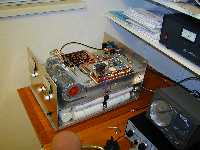 D...
D... E...
E...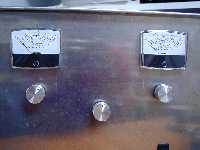 F...
F... G...
G... H...
H... I...
I... J...
J... K...
K... L...
L... M...
M... N...
N...O...
P
In order for an amplifier like this to be legal, according to FCC rules the harmonic emissions must be below a certain level. Although the 2nd harmonic on a push pull amlifier is low due to the design of the amplifier, the 3rd harmonic is only down about 12 to 15 db. In order to attenuate both the 2nd and 3rd harmonics on each band, five switchable filters were constructed. Each filter is a 7-section eliptical filter that is switched in for the appropriate band. The chart below shows the specifics:
Filter Band -3db Frequency -30db
Frequency
1 160
3 Mhz
3.5 Mhz
2 80
6 Mhz
7 Mhz
3 40/30
12 Mhz
13.7 Mhz
4 20/17
25 Mhz
27.2 Mhz
5 15/12/10
35 Mhz
40.3 Mhz
Each filter required 3 inductors and 7 capacitors. Air inductors were used where possible to cut down the cost and heat due to core losses. The only place that powdered iron toroids had to be used was in the 160 meter filter. All capacitors are 500 volt silver mica capacitors. Some of the capacitors were formed by placing capacitors in parallel in order to create the correct value and/or to increase the current capability at the lower frequencies. Pictures A and B show the top of the filter board. Picture C shows the bottom. Pictures D and E show the filter board installed in the amplifier. A ferrite choke was placed around the control cable to keep the RF from geting into the metering circuits. At this point, a directional coupler must be built and calibrated before the meter faces can be finished. After that and some tidying up is done on some of the wiring, the case will be painted and the project will be done. Photo F shows the front panel with the calibrated meters installed. This panel is removed by unscrewing a few screws and unplugging the connecting cable, which is shown in G and H. Photo I shows the control board and J shows the back of the amplifier. Note the cooling exhaust port. Photos K and L show the SWR bridge. The bridge consists of a piece of semi-rigid coax for the primary of the transformer. The shield is grounded on one end to give electrostatic shielding. The toroid is a T50-2 core with 30 turns of number 30 bifilar wire twisted together. The center tap is tied to a capacitive divider for nulling the reflected power. This bridge is accurate and flat to a db from 160 through 10 meters. It also has an op amp built in so it gives a true peak power reading. Pictures M and N show a transformer attenuator that is flat to +/- 0.5 db from 160 through 10 meters. The transformer, which is a T50-2 toroid with 60 turns of #30 wire, provides about 36 db of attenuation and the resistive pad provides 4 db of attenuation for a total of about 40 db. This allows the monitoring of a high power amplifier with an ocilloscope. The schematic is shown in picture O with the turns adjusted to 63 turns to provide 36 db of attenuation. Picture P shows an attenuation plot of the 60 turn model and the 63 turn model. You can see that the nominal attenuation is 39.5 db on the 60 turn model and closer to 40 db on the 63 turn model.
Click here to return to Amateur Radio. Click here to return to the main page.